Excerpts from Jim Conrad's
Naturalist Newsletter
entry from field notes dated January 20, 2023, taken in scrub ~1.5km south of Camargo, elevation ±1,700m (7280 ft); bedrock of fine-grained, calcareous mudrock; Querétaro state, MÉXICO, (N21.09°, W99.73°)
DYSCRITOTHAMNUS FILIFOLIUS
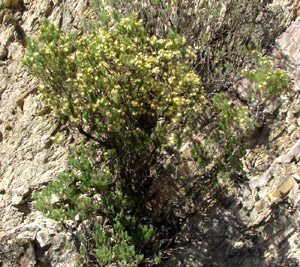
At the base of an old roadcut the woody bush shown at the right rooted in rocky talus. It was loaded with white, puffy fruiting heads as seen in the Composite/Aster/Sunflower Family, the Asteraceae. Below it, a young sprout or maybe a new plant had developed with no flowering heads, and above it an older plant seemed to be fading, losing its leaves. It was the dry season, and the rainy season had never properly developed, so maybe the old plant was dying.

Up close, the fruiting heads had disseminated into the wind most of their one-seeded, cypsela-type fruits, but a few remained. Atop each cypsela arose a white, parachute-like pappus, displaying a starburst form. All that was typical of the Aster Family, but something remarkable was that these heads appeared on stems bearing leaves looking like needles on a spruce tree, which is a gymnosperm. Up closer, the pappuses showed more surprising features:
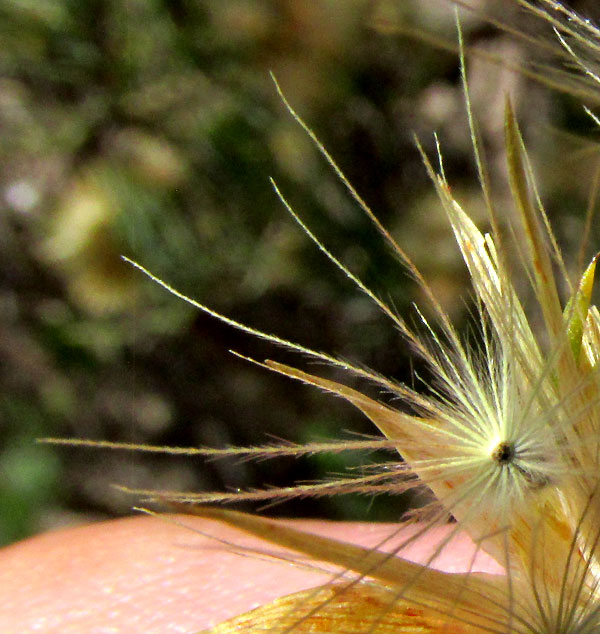
Instead of identical, simple white bristles normal for this kind of pappus, the bristles varied greatly in length, plus each bristle bore many short, soft hairs along its sides, lending the bristle a feathery, or plumose, appearance. At the base, bristles united around a kind of dark disc.
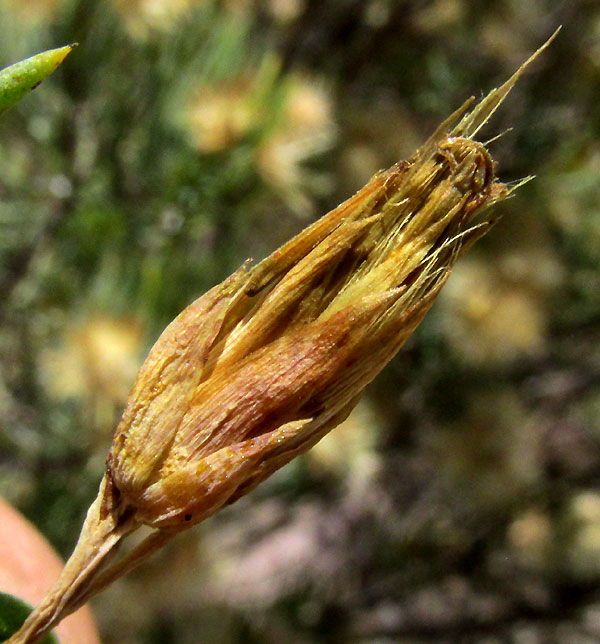
Above, on an unopened head, scale-like bracts, or phyllaries, covering the involucre surrounding the head's lower parts likewise was unusual. The phyllaries were uncommonly large and few in number, of different lengths, and each bract bore several longitudinal ribs.
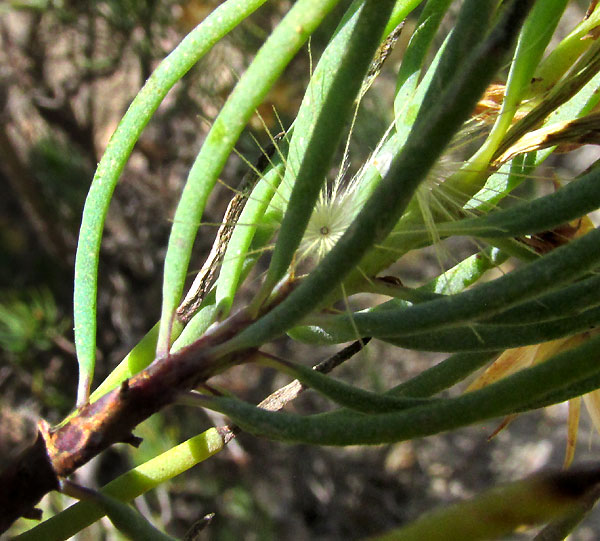
The spruce-like leaves were round in cross-section, and diminished at their bases into short stems, or stipes. When leaves fell off, the stipes remained on the stem, just as happens on spruce stems.
The Aster Family is the largest of all flowering plant families, so often the genera and species are hard to identify, especially. Therefore, it was fortunate that farther down the trail, the flowering head shown below turned up on a different plant, apparently of the same species:
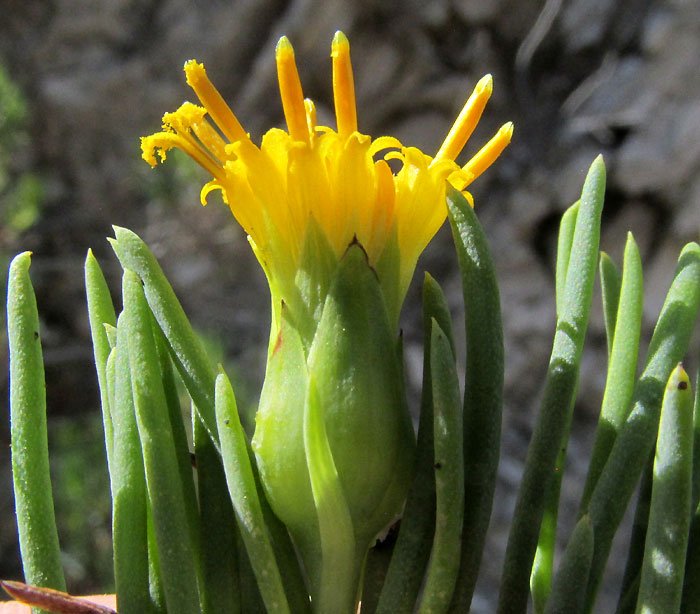
Note that the phyllaries are few in number and unusually broad, with similarly widely spaced longitudinal ribs, and are sharp-tipped, as on the fruiting heads. Now it's clear that this species produces no ray florets, and are yellow. Here's a shot from above:
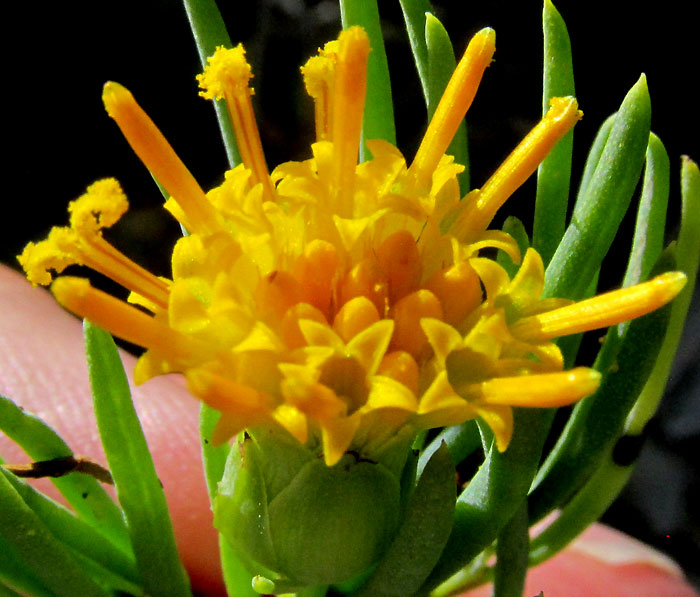
At first I thought this might be the Pygmy Cedar, Peucephyllum schottii, of the US desert Southwest and northwestern Mexico, with very similar flowers and leaves. However, not only did that species not occur in our central Mexican uplands, but also it produced simple, not plumose, pappus bristles.
Fortunately, this species is documented and nicely described and illustrated in the Flora del Bajío, which covers our part of upland central Mexico. Our plant is DYSCRITOTHAMNUS FILIFOLIUS. And when more information on this name was looked up our plant turned out to be as remarkable as it had seemed it might be.
One reason the species is unusual is that it grows naturally only in a small part of the state of Hidalgo, and across central Querétaro, where in some locations it's abundant. You can see where it's been documented on its GBIF Dyscritothamnus filifolius page.
Another unusual feature is its narrow adaptation to a very specific habitat. It's described as living on vertical or almost-vertical walls of limestone, shales or marls, including roadcuts -- habita sobre paredes verticales o casi verticales de calizas, lutitas o margas, frecuentemente también sobre taludes de carreteras. The original Spanish is included because it so exactly describes what ecologists call this species' "niche conservatism."
Also of special interest is that there's a second species in the same small genus Dyscritothamnus -- Dyscritothamnus mirandae, which occupies the same habitats in the same tiny distribution area. The situation is analyzed in the 2015 work of Mario Ernesto Suárez-Mota and others entitled "Ecological niche similarity between congeneric Mexican plant species." That 2015 work claims that there's no evidence of hybridization between the two species, though the earlier 2008 treatment in the Flora del Bajío not only says that they do, and on a map shows where hybrids have been found.
The naming of Dyscritothamnus filifolius has an interesting story. The species was first collected in 1840 by Carl August Ehrenberg, who vaguely noted that the plant grew on steep mountain slopes between Las Ajuntas and Las Ranas, somewhere in Mexico. Las Ajuntas and Las Ranas can't be located on today's maps. Moreover, in the 1840s no one could figure out where in the vast Aster Family this collection, Ehrenberg 1075, should be assigned.
The pressed and dried collection was housed as an anonymous member of the Aster Family at Germany's Botanical Museum at Berlin-Dahlem until in 1905 it was noticed by Benjamin Lincoln Robinson, a US botanist visiting from Harvard. Robinson asked to borrow the collection so he could study and name it. He couldn't identify it, and after years of ruminating on the matter decided it had to be something new to science. In 1922, not only did he introduce to science the new species, but also he erected a new genus to host the species. This he did in an article entitled "Dyscritothamnus, a New Genus of Compositae." At this writing only the two species mentioned above comprise the genus.
Robinson ended his publication with the remark that the generic name -- the dyscrito meaning "hard to determine," and thamnus meaning "shrub" -- seems to be justifiable.